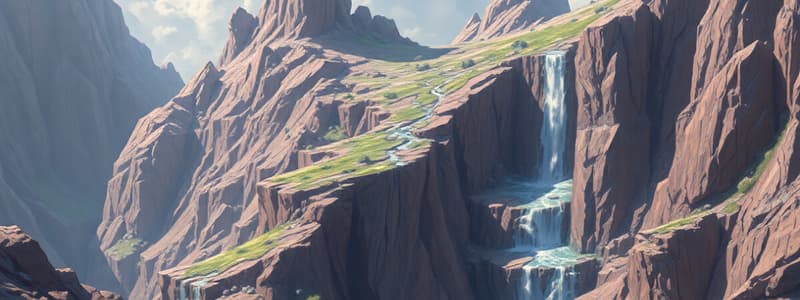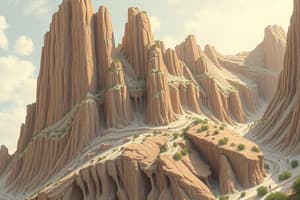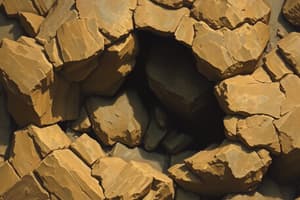Podcast
Questions and Answers
Which geological feature is formed from sediment, metamorphosed rock, and oceanic crust scraped from a subducting plate and 'stuck' to the edge of a continental plate?
Which geological feature is formed from sediment, metamorphosed rock, and oceanic crust scraped from a subducting plate and 'stuck' to the edge of a continental plate?
- A mid-ocean ridge
- An accretionary wedge (correct)
- An oceanic trench
- A volcanic arc
What type of fold describes rocks that have been bent upwards, resembling an arch?
What type of fold describes rocks that have been bent upwards, resembling an arch?
- Monocline
- Anticline (correct)
- Basin
- Syncline
If a circular geological structure is eroded, and the youngest rocks are exposed in the middle, what is this structure called?
If a circular geological structure is eroded, and the youngest rocks are exposed in the middle, what is this structure called?
- Syncline
- Horst
- Basin (correct)
- Dome
Under what conditions do rocks typically undergo brittle deformation, leading to fracturing?
Under what conditions do rocks typically undergo brittle deformation, leading to fracturing?
What type of stress is primarily responsible for the formation of folded mountains?
What type of stress is primarily responsible for the formation of folded mountains?
After erosion, you observe a circular geological structure where the oldest rock layers are exposed in the center. What is this structure most likely to be?
After erosion, you observe a circular geological structure where the oldest rock layers are exposed in the center. What is this structure most likely to be?
Where are you most likely to find rocks undergoing ductile deformation?
Where are you most likely to find rocks undergoing ductile deformation?
What geological feature is defined as a fracture in the Earth's crust where significant movement has occurred?
What geological feature is defined as a fracture in the Earth's crust where significant movement has occurred?
Which type of stress is responsible for the formation of fault-block mountains, characterized by horsts and grabens?
Which type of stress is responsible for the formation of fault-block mountains, characterized by horsts and grabens?
What type of fault is most commonly associated with the formation of folded mountains?
What type of fault is most commonly associated with the formation of folded mountains?
In an inclined fault, what is the term for the block of rock that lies on the underside?
In an inclined fault, what is the term for the block of rock that lies on the underside?
What is the term for a depressed block of crust bordered by normal faults?
What is the term for a depressed block of crust bordered by normal faults?
In an inclined fault, what is the name given to the upper or overhanging wall?
In an inclined fault, what is the name given to the upper or overhanging wall?
What is a raised, elongated block of the earth's crust, situated between two normal faults, known as?
What is a raised, elongated block of the earth's crust, situated between two normal faults, known as?
What geological concept describes the equilibrium in which the Earth's crust floats in gravitational balance upon the mantle?
What geological concept describes the equilibrium in which the Earth's crust floats in gravitational balance upon the mantle?
Which of the following best describes rocks folded in a step-like pattern?
Which of the following best describes rocks folded in a step-like pattern?
Which type of fault is caused by tensional stress, resulting in the hanging wall moving downward relative to the footwall?
Which type of fault is caused by tensional stress, resulting in the hanging wall moving downward relative to the footwall?
What is the term for the process of mountain building?
What is the term for the process of mountain building?
What type of fault is caused by compressional stress, where the hanging wall moves upward relative to the footwall?
What type of fault is caused by compressional stress, where the hanging wall moves upward relative to the footwall?
A geologist observes a fault where the primary movement is horizontal and parallel to the fault's surface, with little to no vertical displacement. What type of fault is this?
A geologist observes a fault where the primary movement is horizontal and parallel to the fault's surface, with little to no vertical displacement. What type of fault is this?
Flashcards
Accretionary wedge
Accretionary wedge
A wedge-shaped mass of sediment, metamorphosed rock, and oceanic crust scraped from a subducting plate and accreted to the edge of a continental plate.
Anticline
Anticline
Rocks folded upward, resembling an arch.
Basin
Basin
A downwarped region where the youngest rocks are in the center after erosion.
Brittle deformation
Brittle deformation
Signup and view all the flashcards
Compressional stress
Compressional stress
Signup and view all the flashcards
Dome
Dome
Signup and view all the flashcards
Ductile deformation
Ductile deformation
Signup and view all the flashcards
Fault
Fault
Signup and view all the flashcards
Fault block mountains
Fault block mountains
Signup and view all the flashcards
Folded mountains
Folded mountains
Signup and view all the flashcards
Foot wall
Foot wall
Signup and view all the flashcards
Hanging wall
Hanging wall
Signup and view all the flashcards
Horst
Horst
Signup and view all the flashcards
Isostasy
Isostasy
Signup and view all the flashcards
Monocline
Monocline
Signup and view all the flashcards
Normal fault
Normal fault
Signup and view all the flashcards
Orogenesis
Orogenesis
Signup and view all the flashcards
Reverse fault
Reverse fault
Signup and view all the flashcards
Shear stress
Shear stress
Signup and view all the flashcards
Strain
Strain
Signup and view all the flashcards
Study Notes
- An accretionary wedge consists of sediment, metamorphosed rock, and oceanic crust scraps scraped from a subducting plate, essentially "stuck" to an overriding continental plate's edge.
- An anticline describes rocks folded upward.
- A basin is a downwarped, circular or elongated region where, after erosion, the youngest rocks are found in the middle.
- Brittle deformation occurs when rocks fracture near the Earth's surface due to low temperatures and confining pressures.
- Compressional stress results from forces that push rocks together.
- A dome is an uplifted, circular or elongated region; after erosion, the oldest rocks are in the middle.
- Ductile deformation happens when rocks flow deep beneath the Earth's surface, where temperatures and confining pressures are high.
- A fault represents a fracture in the Earth's crust where movement has occurred.
- Fault block mountains are formed by tensional stress, where normal faults produce horsts and grabens.
- Folded mountains are primarily formed by compressional stress, with reverse and thrust faults being common.
- The foot wall is the block of rock on the underside of an inclined fault.
- A graben is a depressed block of the Earth’s crust bordered by normal faults.
- The hanging wall is the upper or overhanging wall of an inclined fault.
- A horst is a raised, elongated block of the Earth's crust located between two normal faults.
- Isostasy refers to the concept of a floating crust in gravitational balance on top of a denser mantle.
- A monocline describes rocks folded in a step-like pattern.
- A normal fault is caused by tensional stress, where the hanging wall moves down relative to the foot wall.
- Orogenesis is the term for mountain building.
- A reverse fault is caused by compressional stress, where the hanging wall moves up relative to the foot wall.
- Shear stress is caused by forces that make rocks slide past each other.
- Strain is the change in shape or volume of rock as a result of forces acting on it.
- Stress refers to the force per unit area acting on a solid.
- A strike-slip fault is caused by shear stress, with movement primarily along the fault's strike and minimal vertical displacement.
- Subduction is the process at convergent boundaries where one tectonic plate moves under another and sinks into the mantle.
- A syncline refers to rocks folded downward.
- Tensional stress is caused by forces that pull rocks apart.
- A terrane is an accreted crustal block.
- A thrust fault is a low-angle (10-15 degree) fault caused by compressional stress.
- A transform fault is also known as a strike-slip fault.
- An uplifted mountain is an elevated landform formed by the vertical movement of the Earth's crust due to tectonic forces.
Studying That Suits You
Use AI to generate personalized quizzes and flashcards to suit your learning preferences.




